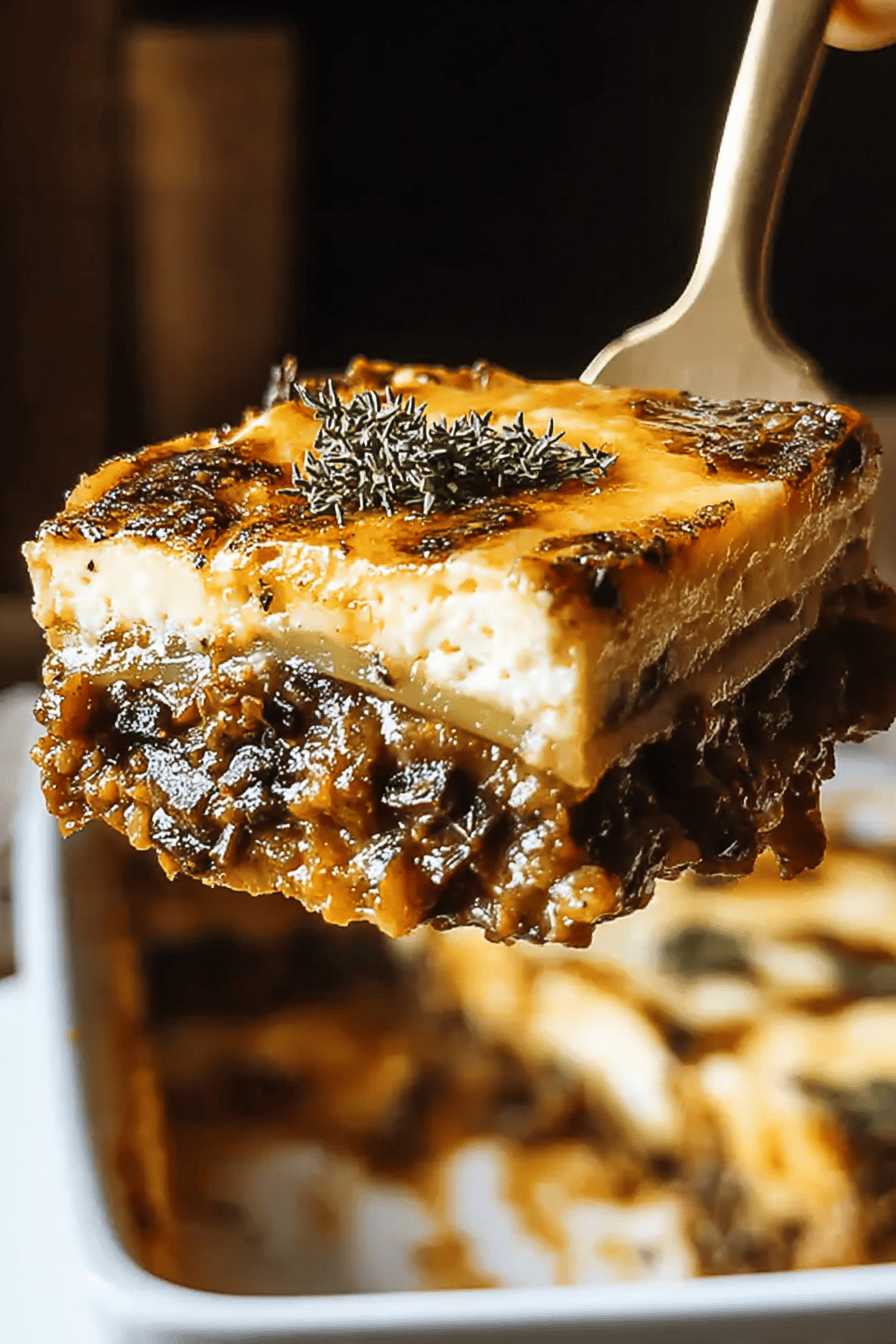Why You’ll Love This Greek Moussaka Recipe
This Greek Moussaka Recipe is a comforting classic that’s sure to become a family favorite. Imagine layers of tender eggplant, savory meat sauce, and a creamy topping that turns a simple dinner into something special. It’s the kind of dish that brings everyone to the table with its rich flavors and satisfying textures, making it ideal for busy nights or special occasions.
One reason you might fall for this Greek Moussaka Recipe is its ease of preparation. This recipe is straightforward and quick, perfect for those who want a delicious meal without spending hours in the kitchen. With easy-to-follow steps and minimal prep time, you can enjoy authentic Greek flavors in no time.
Health benefits play a big role too, as it’s loaded with fresh vegetables, lean proteins, and nutritious ingredients. This version offers a wholesome dish that supports a balanced diet and wellness, with its rich flavors coming without excessive calories or unhealthy fats. Think of it as a smart way to enjoy comfort food while staying mindful of what you eat.
Versatility is another highlight, allowing you to adapt it to different dietary needs. You can modify this Greek Moussaka Recipe easily to be vegan, gluten-free, or low-calorie without sacrificing taste, making it suitable for a wide range of preferences. Finally, the distinctive flavor from the spiced meat, creamy béchamel, and tender eggplants sets it apart, bringing a taste of Greece to your table.
Jump To
- 1. Why You’ll Love This Greek Moussaka Recipe
- 2. Essential Ingredients for Greek Moussaka Recipe
- 3. How to Prepare the Perfect Greek Moussaka Recipe: Step-by-Step Guide
- 4. Dietary Substitutions to Customize Your Greek Moussaka Recipe
- 5. Mastering Greek Moussaka Recipe: Advanced Tips and Variations
- 6. How to Store Greek Moussaka Recipe: Best Practices
- 7. FAQs: Frequently Asked Questions About Greek Moussaka Recipe
- 8. Greek Moussaka Recipe
Essential Ingredients for Greek Moussaka Recipe
Every great Greek Moussaka Recipe starts with the right ingredients, and this one pulls together fresh, flavorful components for an unforgettable meal. You’ll need items for the eggplant, filling, béchamel sauce, and topping to create those iconic layers. Let’s break it down so you can see exactly what’s required and why each part matters.
For the Eggplant
- 1 kilogram eggplant, sliced to 0.75 centimeter thickness
- 1 teaspoon salt
- 2 to 3 tablespoons olive oil
For the Filling
- 1 tablespoon olive oil
- 1 diced onion
- 3 minced garlic cloves
- 1.4 pounds ground beef or lamb
- 0.5 cup dry red wine (optional)
- 14 ounces crushed tomatoes
- 3 tablespoons tomato paste
- 1 cup beef broth
- 1 beef bouillon cube
- 2 bay leaves
- 1.5 teaspoons sugar
- 2 teaspoons dried oregano
- 0.5 teaspoon ground cinnamon
- 0.75 teaspoon salt
For the Béchamel Sauce
- 4 tablespoons butter
- 5 tablespoons plain flour
- 2.5 cups milk
- 0.25 teaspoon ground nutmeg
- 0.5 cup grated Parmesan cheese
- 1 whole egg
- 1 egg yolk
- 1.25 teaspoons stock powder
- 0.25 teaspoon ground black pepper
For the Topping
- 0.33 cup panko breadcrumbs
These ingredients form the backbone of your Greek Moussaka Recipe, blending together for a dish that’s both hearty and delicious. For special dietary options, you can swap ground meat with lentils for a vegan twist or use gluten-free flour in the béchamel to make it suitable for more eaters.
How to Prepare the Perfect Greek Moussaka Recipe: Step-by-Step Guide
Ready to dive into making this Greek Moussaka Recipe? It’s simpler than it looks, and following these steps will have you serving up a gourmet meal in your own kitchen. We’ll walk through each part, from prepping the eggplant to baking everything together, so even if you’re new to cooking, you can handle it with ease.
First, start with the eggplant slices. Slice the eggplants lengthwise about 1/2 inch thick, then salt them generously and set aside for 30 minutes to remove bitterness. Rinse and pat dry, optionally brush with olive oil, and roast or grill until soft, just like in this traditional Greek Moussaka Recipe technique. This step keeps your layers from getting soggy and brings out the best flavors.
Next, move on to the meat sauce. In a large pan, heat olive oil and sauté onions and garlic until translucent, then add ground lamb or beef and cook until browned. For a Greek Moussaka Recipe with eggplant layers, pour in canned tomatoes and red wine; simmer for 30 minutes until thickened, seasoning with salt, pepper, cinnamon, and nutmeg. If you’re going vegan, substitute the meat with cooked lentils for a tasty variation.
Now, prepare the béchamel sauce. Melt butter in a saucepan, stir in flour, and cook for 2 minutes to make a smooth base. Gradually whisk in milk until thickened, then remove from heat and stir in beaten eggs and grated Parmesan cheese. Remember, for a gluten-free Greek Moussaka Recipe, use alternative flour to keep things inclusive. The eggplant slices are salted and rested to remove excess moisture, then baked until softened, ensuring a perfect texture.
Preheat your oven to 180°C (350°F) for the assembly. In a baking dish, layer half the eggplants, spread the meat sauce, then add the rest of the eggplants. Pour the béchamel sauce evenly on top and sprinkle with breadcrumbs. Bake for 45-50 minutes until it’s golden and bubbling, then let it cool for 10 minutes before serving. The meat sauce is prepared by sautéing onion and garlic, browning the ground meat, optionally adding wine, then simmering with tomatoes, broth, spices, and seasonings. This technique ensures well-set layers and enhanced flavors, so adjust for your preferences.
Dietary Substitutions to Customize Your Greek Moussaka Recipe
One of the joys of this Greek Moussaka Recipe is how easy it is to tweak for different needs. Whether you’re watching your calories or following a special diet, you can make adjustments without losing that signature taste. Let’s look at some simple swaps that keep things delicious and flexible.
For protein and main components, you might replace ground lamb or beef with ground turkey or chicken for a lighter option. Another idea is to use cooked lentils, mushrooms, or plant-based mince for a vegan or vegetarian Greek Moussaka Recipe. If you’re a pescatarian, try swapping the meat with chopped cooked fish or seafood to add a fresh twist. These changes help maintain the hearty feel while fitting your lifestyle.
Vegetable, Sauce, and Seasoning Options
- Swap eggplants with zucchini or potatoes depending on the season or your preference, giving your Greek Moussaka Recipe a new vibe.
- Use coconut or almond milk in the béchamel for dairy-free adaptations that still feel creamy.
- Experiment with herbs like oregano, thyme, or rosemary to alter the flavor profile and keep things exciting.
- For gluten-free variants, opt for cornstarch or rice flour instead of wheat flour in the sauce to make it accessible for everyone.
With these tweaks, your Greek Moussaka Recipe can be a canvas for creativity, ensuring it’s enjoyable no matter your dietary choices. The béchamel sauce is made by cooking butter and flour, gradually whisking in milk until thickened, then adding cheese, nutmeg, stock powder, pepper, and eggs after cooling, so adapt accordingly for delicious layered dishes like lasagna.
| Original Ingredient | Substitution Option |
|---|---|
| Ground beef or lamb | Lentils or plant-based mince |
| Plain flour | Gluten-free flour |
| Milk | Almond milk |
Mastering Greek Moussaka Recipe: Advanced Tips and Variations
If you’re ready to take your Greek Moussaka Recipe to the next level, these pro tips will help you impress. From perfecting the layers to adding your own spin, it’s all about building confidence in the kitchen. Remember, even small changes can make a big difference in flavor and presentation.
Pro cooking techniques are key here. Salt the eggplants to reduce bitterness and moisture, then roast for intensified flavor, making sure the béchamel is smooth by slowly adding liquids. For a Greek Moussaka Recipe with meat sauce and eggplant, these steps ensure everything comes together perfectly. Flavor variations like adding a pinch of cinnamon or allspice to the meat sauce bring a warm touch, while smoked paprika adds a subtle smokiness that elevates the dish.
Presentation matters too, so garnish with fresh parsley or mint and pair it with a Greek salad for a colorful plate. The dish is assembled by layering half the eggplant, covering with the meat sauce, topping with the remaining eggplant, pouring over the béchamel, sprinkling with breadcrumbs, and baking until golden. Make-ahead options let you assemble everything the day before, chill it in the fridge, and bake when needed to save time and let flavors blend. For more casserole ideas, check out tasty chicken taco casseroles on the site.
How to Store Greek Moussaka Recipe: Best Practices
Storing your Greek Moussaka Recipe right keeps it tasty for leftovers or future meals. Whether you’re prepping ahead or saving extras, follow these tips to maintain that fresh-baked goodness. It’s all about keeping the flavors intact without much fuss.
For refrigeration, cool the moussaka completely before covering and storing in an airtight container for up to 3-4 days. Freezing works great too, so portion it into airtight containers and freeze for up to 2 months, then thaw in the fridge overnight before reheating. When reheating, use a preheated oven at 180°C (350°F) until it’s warmed through to preserve the texture and flavor of your Greek Moussaka Recipe.
Meal prep considerations make this even handier, as you can prepare and freeze individual servings for quick meals on busy days. This ensures consistent quality and convenience, so you always have a homemade option ready. The béchamel sauce, with its creamy topping, holds up well with these methods, making your Greek Moussaka Recipe a smart choice for weekly planning.

FAQs: Frequently Asked Questions About Greek Moussaka Recipe
What are the main ingredients needed to make traditional Greek moussaka?
Traditional Greek moussaka typically includes eggplants, ground lamb or beef, onions, garlic, tomatoes, olive oil, and a béchamel sauce made from butter, flour, milk, and eggs. Additional spices like cinnamon, nutmeg, and allspice add authentic flavor. Some recipes also layer in potatoes for extra texture. Using fresh vegetables and quality meat helps create the rich, hearty dish that moussaka is known for.
How do you prepare eggplants for Greek moussaka to avoid bitterness?
To reduce bitterness and excess moisture, slice the eggplants and sprinkle them generously with salt. Let them sit in a colander for about 30 minutes, then rinse and pat dry with paper towels. This process helps draw out bitter juices and prevents the moussaka from becoming watery during baking. Afterward, lightly fry or roast the eggplant slices until golden before layering them in the dish.
Can I make Greek moussaka ahead of time and reheat it?
Yes, Greek moussaka can be made a day ahead. After baking, allow it to cool completely, then cover and refrigerate. Reheat in the oven at 350°F (175°C) for 20-30 minutes until warmed through. Preparing moussaka in advance allows the flavors to meld, often improving the taste. For longer storage, moussaka freezes well; wrap portions tightly and thaw overnight before reheating.
What is the best way to make the béchamel sauce for moussaka?
To make béchamel sauce, melt butter in a saucepan over medium heat, then whisk in flour to form a smooth roux. Slowly add warm milk while continuously whisking to avoid lumps. Cook until the sauce thickens, then remove from heat and stir in beaten eggs and a pinch of nutmeg. The sauce should be creamy and pourable, creating the rich, velvety topping that sets perfectly when baked.
Is Greek moussaka gluten-free, and how can I adapt the recipe?
Traditional moussaka contains gluten due to the flour used in the béchamel sauce. To make it gluten-free, substitute the all-purpose flour with a gluten-free flour blend or cornstarch for thickening the sauce. Ensure that all other ingredients, like spices and broth, are also gluten-free. This adjustment keeps the dish accessible for those with gluten intolerance while maintaining its classic creamy texture.

Greek Moussaka Recipe
- Total Time: 1 hour 45 minutes
- Yield: 6 servings
- Diet: Non-vegetarian
Description
🍆 This Moussaka recipe offers a comforting and satisfying meal with layers of tender eggplant, savory meat sauce, and a creamy béchamel topping.
🥘 It’s perfect for those who enjoy hearty Mediterranean dishes that combine rich flavors and textures in every bite.
Ingredients
– 1 kilogram eggplant, sliced to 0.75 centimeter thickness
– 1 teaspoon salt
– 2 to 3 tablespoons olive oil
– 1 tablespoon olive oil
– 1 diced onion
– 3 minced garlic cloves
– 1.4 pounds ground beef or lamb
– 0.5 cup dry red wine (optional)
– 14 ounces crushed tomatoes
– 3 tablespoons tomato paste
– 1 cup beef broth
– 1 beef bouillon cube
– 2 bay leaves
– 1.5 teaspoons sugar
– 2 teaspoons dried oregano
– 0.5 teaspoon ground cinnamon
– 0.75 teaspoon salt
– 4 tablespoons butter
– 5 tablespoons plain flour
– 2.5 cups milk
– 0.25 teaspoon ground nutmeg
– 0.5 cup grated Parmesan cheese
– 1 whole egg
– 1 egg yolk
– 1.25 teaspoons stock powder
– 0.25 teaspoon ground black pepper
– 0.33 cup panko breadcrumbs
Instructions
1-First, start with the eggplant slices. Slice the eggplants lengthwise about 1/2 inch thick, then salt them generously and set aside for 30 minutes to remove bitterness. Rinse and pat dry, optionally brush with olive oil, and roast or grill until soft, just like in this traditional Greek Moussaka Recipe technique. This step keeps your layers from getting soggy and brings out the best flavors.
2-Next, move on to the meat sauce. In a large pan, heat olive oil and sauté onions and garlic until translucent, then add ground lamb or beef and cook until browned. For a Greek Moussaka Recipe with eggplant layers, pour in canned tomatoes and red wine; simmer for 30 minutes until thickened, seasoning with salt, pepper, cinnamon, and nutmeg. If you’re going vegan, substitute the meat with cooked lentils for a tasty variation.
3-Now, prepare the béchamel sauce. Melt butter in a saucepan, stir in flour, and cook for 2 minutes to make a smooth base. Gradually whisk in milk until thickened, then remove from heat and stir in beaten eggs and grated Parmesan cheese. Remember, for a gluten-free Greek Moussaka Recipe, use alternative flour to keep things inclusive. The eggplant slices are salted and rested to remove excess moisture, then baked until softened, ensuring a perfect texture.
4-Preheat your oven to 180°C (350°F) for the assembly. In a baking dish, layer half the eggplants, spread the meat sauce, then add the rest of the eggplants. Pour the béchamel sauce evenly on top and sprinkle with breadcrumbs. Bake for 45-50 minutes until it’s golden and bubbling, then let it cool for 10 minutes before serving. The meat sauce is prepared by sautéing onion and garlic, browning the ground meat, optionally adding wine, then simmering with tomatoes, broth, spices, and seasonings. This technique ensures well-set layers and enhanced flavors, so adjust for your preferences.
Notes
🧂 Salting the eggplant and letting it rest reduces bitterness and excess moisture.
🍅 Simmer the meat sauce gently to develop deep, rich flavors.
🥄 Gradually whisk the béchamel sauce to avoid lumps and achieve a smooth consistency.
- Prep Time: 20 minutes
- Resting time for eggplant: 30 minutes
- Cook Time: 55-60 minutes
- Category: Main Course
- Method: Baking
- Cuisine: Mediterranean
Nutrition
- Serving Size: 1 slice
- Calories: 450 calories
- Sugar: 7 grams
- Sodium: 600 milligrams
- Fat: 25 grams
- Saturated Fat: 12 grams
- Unsaturated Fat: 10 grams
- Trans Fat: 0 grams
- Carbohydrates: 35 grams
- Fiber: 6 grams
- Protein: 25 grams
- Cholesterol: 110 milligrams
Keywords: Moussaka, Eggplant, Meat Sauce, Béchamel


